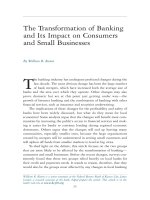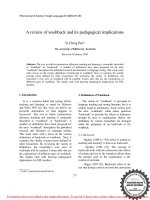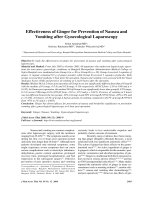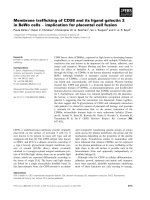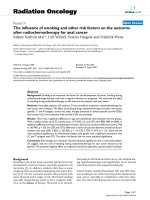Magnitude of nausea and or vomiting and its associated factors among mothers taking spinal anesthesia for cesarean section at gandhi memorial hospital, addis ababa, ethiopia
Bạn đang xem bản rút gọn của tài liệu. Xem và tải ngay bản đầy đủ của tài liệu tại đây (803.64 KB, 47 trang )
Magnitude of nausea and or vomiting and its associated factors among
mothers taking spinal anesthesia for cesarean section at Gandhi memorial
hospital, Addis Ababa, Ethiopia
By – AbereTilahun (BSc in anesthesia)
A thesis submitted to the department of anesthesia, college of medicine &
health science, Addis Ababa University in partial fulfillment of the
requirements for the MSc in advanced clinical anesthesia
June, 2017
Addis Ababa, Ethiopia
i
Addis Ababa University College of medicine & health science school of anesthesia
Magnitude of nausea and or vomiting and its associated factors among mothers
taking spinal anesthesia for cesarean section at Gandhi memorial hospital, Addis
Ababa, Ethiopia, 2017
By – Abere Tilahun (BSc in anesthesia)
Advisor
Misrak w/yohannes (Bsc, MSC in anesthesia)
Addis Ababa, Ethiopia
June, 2017
ii
CERTIFICATION
The undersigned certify that the research entitled Magnitude of nausea and or vomiting and its
associated factors among mothers taking spinal anesthesia for cesarean section at Gandhi
memorial hospital, Addis Ababa, Ethiopia
Institutional based cross sectional study is my
original work and any literature and/or data cited in this article were listed in the reference
section and any assist done during this period has been given an acknowledgement.
Author
Name ________________________ Signature ______________ Date ______________
Approval of the Board of Examiners
1. Advisor
Name ________________________ Signature ______________ Date ______________
2. Internal Examiner
Name _________________________ Signature ______________ Date ______________
3. External Examiner
Name __________________________ Signature ______________ Date ______________
I
Acknowledgements
First, I would like to thanks my advisor Misrak W/yohannes (Msc) for her continuous unreserved
guidance, comments and valuable advice to develop this research paper.
My gratitude is extended to particularly Mr. Leulayehu Akalu (Msc) hade of school of anesthesia
at Addis Ababa University for his enormous support during title selection.
My hart full gratitude also extends to Addis Ababa University department of anesthesia staff for
their support and facilitating time for thesis wright up.
Lastly, I would like to thanks Addis Ababa University for financial support
II
Acronyms
AAU
Addis Ababa University
AAUECC
Addis Ababa University Ethical Clearance Comity
ASA
American Society of Anesthesiologists
BMI
Body mass index
BP
Blood Pressure
BSc
Bachelor science
CD
Cesarean Delivery
DC
Data Collector
GMH
Gandhi memorial Hospital
IONV
Intraoperative Nausea and Vomiting
IV
Intravenously
MSc
Master of Science
NPO
Non-Per Oral
NSIDS
None steroidal anti-inflammatory dugs
PI
Principal Investigator
PONV
Postoperative Nausea and Vomiting
S
Supervisor
SAB
Subarachnoid Block
Sao2
Arterial Oxygen Saturation
SPSS
Statistical Package for Social Sciences
VAS
Visual analog score
III
List of tables
Table1: Socio-demographic & premedication characteristics of the study subjects in Gandhi memorial
hospital from March 16 to May 16, 2017. ________________________________________________ 17
Tble2: The relationship between experience of nausea and results of bivariate logistic regression
analysis on hypotension, Gandhi memorial hospital, 2017 (N=140). __________________19
Table 3: The variables or risk factors influencing nausea and or vomiting in Gandhi memorial
hospital, from March 16 to May 16, 2017 ________________________________________ 20
Table 4: Factors associated with postoperative nausea and or vomiting: results of bivariate and
multivariate logistic regression analysis, Gandhi memorial hospital, from March 16 to May 2017
(N=140). ____________________________________________________________________ 21
List of figures
Figure1: Conceptual framework________________________________________________8
Figure2: Proportion of mothers who developed nausea and or vomiting in Gandhi memorial hospital from
March 16 to May 16, 2017 __________________________________________________ 16
Figure3: Proportion of nausea and or vomiting in time pattern Gandhi memorial hospital from March 16
to May 16, 2017____________________________________________________________________16
II
Table of Contents
Acknowledgements ....................................................................................................................................... II
Acronyms ..................................................................................................................................................... III
List of tables.............................................................................................................................................. II
List of figures ............................................................................................................................................ II
Abstract ......................................................................................................................................................... V
Chapter one: Introduction ......................................................................................................................... - 1 1.1 Back ground .................................................................................................................................... - 1 1.2 Statement of the Problem ................................................................................................................ - 3 1.3. Justification of the Study ............................................................................................................... - 4 Chapter Two: Literature Review............................................................................................................... - 5 2.1 conceptual frame work .................................................................................................................... - 8 Chapter Three: Objectives ........................................................................................................................ - 9 3.1. General Objective .......................................................................................................................... - 9 3.2. Specific objectives ......................................................................................................................... - 9 Chapter Four: Methodology .................................................................................................................... - 10 4.1. Study Design and Period .............................................................................................................. - 10 4.2 Study area...................................................................................................................................... - 10 4.3. Source and study Population ........................................................................................................ - 10 4.3.1. Source population ................................................................................................................. - 10 4.3.2 Study Population .................................................................................................................... - 10 4.4. Inclusion and Exclusion Criteria .................................................................................................. - 10 4.4.1. Inclusion criteria ................................................................................................................... - 10 4.4.2. Exclusion criteria .................................................................................................................. - 10 4.5. Variables ...................................................................................................................................... - 11 4.5.1. Dependent variable ............................................................................................................... - 11 4.5.2. Independent variables ........................................................................................................... - 11 4.6. Operational Definitions ................................................................................................................ - 11 4.7. Sample size determination and Sampling Technique .................................................................. - 12 4.7.1. Sample size determination .................................................................................................... - 12 4.7.2. Sampling Technique .............................................................................................................. - 13 4.8. Data Collection ............................................................................................................................ - 13 III
4.9. Data Quality Control .................................................................................................................... - 13 4.10. Data Analyzing and processing.................................................................................................. - 13 4.11. Ethical considerations ................................................................................................................ - 14 4.12 Dissemination of Results ............................................................................................................ - 14 Chapter Five: Results .............................................................................................................................. - 15 Chapter Six: Discussion .......................................................................................................................... - 21 6.1 limitation ....................................................................................................................................... - 23 Chapter Seven: Conclusion and recommendation .................................................................................. - 24 7.1: Conclusion ................................................................................................................................... - 24 7.2: Recommendation ......................................................................................................................... - 24 9. References ............................................................................................................................................... 25
Annex I: Information Sheet .................................................................................................................... 30
Annex – II: English Questionnaire.......................................................................................................... 31
Annex– III: Amharic Version Questionnaire Consent Form .................................................................. 32
Annex– IV: Questioners ......................................................................................................................... 33
IV
Abstract
Background: Nausea and vomiting during regional anesthesia for cesarean section are very
common and unpleasant events. Can cause significant distress to the patient and interfere with
the surgical procedure. Identifying the factors of nausea and or vomiting during cesarean section
in specific context can help to reduce negative consequence of nausea and or vomiting during
cesarean section delivery.
Objective: The objective of this study was to assess Magnitude of nausea and or vomiting and
its associated factors among mothers taking spinal anesthesia for cesarean section at Gandhi
memorial hospital, Addis Ababa, Ethiopia
Methods: Institutional based cross sectional study was conducted on 140 obstetric mothers who
gave birth under cesarean section with spinal anesthesia at Gandhi memorial hospital from
March to May 2017. Systematic random sampling technique was used to select study participants
from operation order during arrival. Necessary information was obtained from each mother and
medications, producers and vital signs were recorded. Bivariate and multivariate regression
analyses were used to identify risk factor for the development of nausea and or vomiting. P value
blow 0.05 was considered statistically significant
Result: The overall magnitude of nausea and or vomiting was 54.3 %, Factors associated with
postoperative nausea and or vomiting were mothers who did not took metoclopramide
prophylaxis (AOR=2.958, 95% CI: (1.084-8.072), long duration of uterus exteriorization
(AOR=1.387, CI=1.109-1.734) and intraoperative shivering (AOR=6.133, CI=2.17-17.332)
showed strong odds of develop nausea and or vomiting than their counterpart.
Conclusion and recommendation: Nausea and or vomiting among mothers gave birth under
cesarean section with spinal anesthesia is significantly high. This study found that mothers who
did not took metoclopramide prophylaxis, long duration of uterus exteriorization and
intraoperative shivering were factors associated with nausea and or vomiting.
We recommended that metoclopramide prophylaxis should be administered before surgery
V
II
Chapter one: Introduction
1.1 Back ground
Neuraxial anesthesia is the preferred method in cesarean section as general anesthesia is
associated with airway related adverse outcome, aspiration risk, and intraoperative awareness
and increased uterine atony leading to higher blood loss. However, postoperative nausea and
vomiting (PONV) is still the most troublesome adverse event encountered in the recovery room.
It is also very common occurrence after spinal Anesthesia for Cesarean section, Without
antiemetic prophylaxis, the incidence extremely varies from different studies; up to 50-80%
which is distressing for both the woman and her family(1-5).
Several mechanisms may be active simultaneously for occurrence of nausea and vomiting during
cesarean section under spinal anesthesia, which arises from anesthetic and non-anesthetic causes.
Among this Hypotension, occurring during spinal anesthesia for cesarean section during higher
segmental and sympathetic blockade and fast administration of IV bolus oxytocin is one of the
most important etiological factors for intraoperative NV, which may trigger the vomiting center
to induce emesis due to hypoxia (5-6). The rests are increased vagal activity, postoperative pain,
and surgical stimuli, bleeding during surgery, uterotonic agents and some antibiotics. (4-6, 1011, 16-19).
Adequate uterine tone can occur with lower doses of oxytocin (0.5–3) units. A bolus lower dose
of oxytocin during caesarean section was resulted in less hemodynamic changes than a 5-unit
bolus when given before 10u/hour continuous intravenous infusion of oxytocin (12).
The routine use of 5 units’ bolus of oxytocin during cesarean section is no longer recommended
(12).
On the other hand, IV administration Ergometrine found to be less hemodynamic instability but
can have nausea and vomiting by interaction with dopaminergic and serotoninergic alphaadrenergic receptor and incidence is highest about 46% with 0.5-mg IV bolus. However, this
drug is usually given intramuscularly which may produce less emesis (5).
-1-
Different studies also demonstrate the major preventive measures to reduce nausea and vomiting
after spinal Anesthesia for cesarean section. which includes; supplemental oxygen, optimal use
of neuraxial and systemic opioids and strict control of blood pressure by adequate preloading or
co-loading with fluids, administration vasopressors before induction of subarachnoid block and
15 degree left uterine displacement(4,7-9,24,25,27-29).
On the other hand, most studies suggested no single intervention is available to eliminate nausea
and vomiting completely during cesarean section under spinal anesthesia; which in fact was
relied on the anesthetic and surgical techniques used, relative preventive measures taken and
multimodal approaches used for superior results than monotherapy in the presence of multiple
risks (4, 20-27).
Many systematic reviews and Meta-analysis and randomized trials have been done in the
efficacy of different antiemetic agents for the prophylaxis of intraoperative and postoperative
nausea and vomiting when used as monotherapy or in combination (19, 21, 30-33).
Majority of studies done in developed countries showed administration of 10mg metoclopramide
prior to spinal blockage was effective and safe to prevent IONV and early PONV in caesarean
section under spinal anesthesia (17, 34-35). However, most of these studies were conducted by
controlling major intraoperative anesthetic and surgical predisposing factors and excluding
known predictor risks of NV.
-2-
1.2 Statement of the Problem
The obstetric patients are at high risk of nausea and vomiting due to the physiological changes of
pregnancy which can attributed by impaired motility of the esophagus, stomach and small bowel
as a result of smooth muscle relaxation fostered by increased levels of hormones; particularly
progesterone and the large gravid uterus(3) .
It has been demonstrated in several studies previous history of PONV, female gender, motion
sickness, none smoking status, longer duration of surgery and use of IV opioids are the most
important predictive factors associated with an increased risk for postoperative nausea and
vomiting in the general population. Based on the presences predictor risk factors; if none, one,
two, three or four predictor risks present the incidence of PONV were 10, 21, 39, 61 and 79%
respectively (13-15).
Intra operative nausea and vomiting interferes with surgical producer, increase operation time,
risk of bleeding, wound dehiscence, surgical trauma, risk of aspiration, fluid and electrolyte
disturbance and distress to both mother and baby(11).
In Ethiopia, there were a number of studies done on prevalence of post-operative nausea and or
vomiting in different way on general population in both general and regional anesthesia and
reported the prevalence ranges 36% to 43% among this majority of patients were female.
Preventing and treating nausea and or vomiting in CD require an integrated approach based on
identifying the magnitude and addressing the contributing factor. Unlike most government
hospitals, obstetric mothers in Gandhi memorial hospital majority of them were emergency
referral. This may affect pre-operative intervention time like preload, anti-emetic premedication
and reassurance. Here in our set up there are variations in the anesthetic and surgical
management during CD in the perioperative period so that the risk of nausea and vomiting
expected to be high.
-3-
1.3. Justification of the Study
Many studies have been performed to determine the magnitude of nausea and vomiting after
spinal anesthesia in general population but not after CD and to find measures for its prevention.
Even if the problem was indicated in many literatures, it never been studied in our country and
information concerning factors that affect their occurrence is limited. The magnitude of PONV
varies from different studies in different countries.
As best of our search, we could not find research about the problem in Ethiopia. So the
magnitude of PONV in CD under spinal anesthesia is not known in our situation. Knowing its
magnitude and associated factors in our situation helps to recognize the magnitude of the
problem and initiates actions to reduce its occurrence. This research can also help as a back
ground for future researches on related topic by indicating the magnitude and associated risk
factors for PON after CD under spinal anesthesia.
-4-
Chapter Two: Literature Review
Nausea and vomiting after spinal anesthesia for caesarean section is multifactorial. And relatively
high without prophylactic antiemetic (36).
From one large systematic review reported strategies to prevent rather than treat hypotension was
found to be more likely to decrease the incidence of nausea and vomiting.(16) In this regard
lateral uterine displacement, fluid co-hydration or preloading with 10- 20ml/kg or 1000-1500ml
crystalloids
and prophylactic vasopressors have been advocated in order to avoid
hypotension(1,24).
However, studies done by Park and his colleagues to compare the effects of varying amounts of
crystalloid preload (10, 20 and 30 ml/kg) prior to spinal anesthesia; showed that there were no
differences in the incidence of hypotension. On the other hand, studies showed the correlation of
hypotension and IONV during spinal anesthesia for cesarean section (21,37).
when the blood pressure dropped more than 20% from baseline the incidence of IONV was 40 to
66%, but was <10% when the blood pressure was maintained at baseline values with infusion
ephedrine or phenylephrine. These studies clearly showed that strict control of blood pressure
could greatly reduce intraoperative emetic symptoms (37).
As studies showed, the other major contributing factor for the occurrence of IONV is surgical
stimuli or inadequate anesthesia, which includes exteriorization of the uterus, intra-abdominal
manipulation and peritoneal traction during closure (11-12). These maneuvers produce visceral
pain that is mediated by unmylinated C-fibers (38). The incidence is as high as 50%, despite high
thoracic sensory block levels (T4-5, 26).
-5-
The incidence of post-partum nausea was significantly reduced from 38% to 18% when the
uterus was repaired in situ as opposed to after exteriorization and vomiting was also reduced
from 18% to 5%, but was statistically insignificant (39).
Use of intrathecal or IV opioids reduces the incidence of both IONV and PONV nausea and
vomiting by increasing quality of block and reducing visceral pain during surgical manipulation
and postoperative time. (23, 30-41).
On the contrary one previous study found some of the commonly used intrathecal or IV
administer of opioids predispose to postoperative nausea and vomiting in a dose dependent
manner. (42) But intraoperative opioids were not a statistically significant predictor from
multivariate logistic regression of a recent large systematic review study analyses (43).
Systematic review and met analyses done in USA with eleven studies on 702 patients studies
showed; administration of 10mg Metoclopramide resulted in a significant reduction in the
incidence of ION and IOV when given before block placement [relative risk (RR) (95% CI)
=0.27 (0.16, 0.45) and 0.14 (0.03, 0.56), respectively.
The incidence of early (0–4 h) PON and POV [RR (95% CI) =0.47 (0.26, 0.87) and 0.45 (0.21,
0.93), respectively. Overall (0–24 or 4–24 h) PON (RR 0.69; 95% CI 0.52, 0.92) incidence were
also reduced with administration of metoclopramide before block placement (17).
Comparative randomized double blind placebo controlled study in USA determine the efficacy
and safety of 10mg intravenous metoclopramide administered prophylactically before elective
cesarean delivery under spinal anesthesia on 42 patients the result showed significantly lower
incidence of nausea and vomiting both before and after delivery than the control group (saline)
14% and 81% respectively (35).
-6-
Similar previous study conducted in 60 patients; administration of 10 mg metoclopramide before
block placement significantly reduces the incidence of intraoperative nausea and vomiting than
placebo (20% vs. 63%). And the corresponding incidence of nausea and vomiting during 0-3
hours after surgery was 27% and 43%; and during 3-24 hours after surgery was 23% and 37%
respectively, but it was statistically insignificant to the reduce the incidence of postoperative
emesis(44) .
Similar study done in India with 80 patients to compare effects of metoclopramide and other two
antiemetic drugs in the control of PONV showed that the incidence of nausea and vomiting
intraoperative and up to 4 hours postoperative was 30% in the metoclopramide group and 55%
in saline group but the result was statistically insignificant(44).
A randomized clinical trial study aimed to compare the effects of Acupressure and
Metoclopramide on postoperative nausea and vomiting was done102 patients in Caesarean
Sections. This study found the incidence of nausea (50% vs. 20%; p=0.03 with 95%CI) and
vomiting (32.34%vs 11.76%; p value of 0.01) in 6hours postoperative periods was significantly
lower in Metoclopramide group as compared that in the control group. And the mean severity of
nausea within 6 hours after surgery was significantly reduce with metoclopramide compared
with control groups(45).
-7-
2.1 conceptual frame work
Maternal factors
parity
Weight
Smoking history
Motion sickness
N&V history
Anesthetic factors
LA volume
Level of block
Opioid used
Fluid used
Preoperative conditions
Nausea
And or
Vomiting
Surgical factors
Fig 1: conceptual framework
Type of surgery
Duration of surgery
Duration of Uterus
exteriorization
-8-
Preload
baseline V/S
prophylactic antibiotics
prophylactic anti
emetics
NPO time
Chapter Three: Objectives
3.1. General Objective
To assess magnitude and associated factors for nausea and or vomiting following cesarean
section under spinal anesthesia at Gandhi memorial hospital from March 15 to May 15, 2017.
3.2. Specific objectives
To determine magnitude of nausea and or vomiting among mothers who take spinal anesthesia
for cesarean section in Gandhi memorial hospital.
To identify associated factors for intraoperative and postoperative nausea and vomiting
following spinal anesthesia for cesarean section.
-9-
Chapter Four: Methodology
4.1. Study Design and Period
An institutional based cross sectional study was conducted at Gandhi memorial hospital from
March 01 to May 01, 2017.
4.2 Study area
This study was conducted at Gandhi memorial hospital, which is one of the Governmental
Hospitals in Addis Ababa under Addis Ababa Health bureau in kirkos sub city. It provides
obstetrics services for over 2000 women annually besides other Health services and they were
using spinal anesthesia more frequently than General anesthesia for caesarean section.
4.3. Source and study Population
4.3.1. Source population
The Study populations were all mothers who gave birth under caesarean section with spinal
Anesthesia in Gandhi Memorial Hospital.
4.3.2 Study Population
The Study populations were all mothers who gave birth under caesarean section with spinal
Anesthesia during the Study period in Gandhi Memorial Hospital.
4.4. Inclusion and Exclusion Criteria
4.4.1. Inclusion criteria
All mothers planned to have caesarean section under spinal anesthesia with available local
anesthetics were included in the study.
4.4.2. Exclusion criteria
Any mother having acute or chronic medical illness associated with nausea and vomiting
Mother who were received antiemetic medication within 24 hours before surgery as a
treatment
- 10 -
4.5. Variables
4.5.1. Dependent variable
Nausea and/or vomiting
4.5.2. Independent variables
Demographic factors like age, weight, height, ASA status, parity, previous history of PONV or
motion sickness and history of smoking status.
Anesthetic and surgical management: perioperative medications such as opioids, uterotonic
agents, and NSAIDS and amount of fluid preloaded, total intraoperative, volume of local
anesthetics administered and level of sensory block, duration and type of surgery/uterus
exteriorized, hemodynamic changes (BP, PR, Sao2) after spinal anesthesia and intraoperative
administration of vasopressors and supplemental oxygen.
4.6. Operational Definitions
To say the patient has nausea and vomiting following cesarean section under spinal anesthesia,
A patient must have at least one episode of
nausea and/or vomiting in the intraoperative and
early postoperative period.
The decrease in systolic blood pressure >= 20% of baseline values and/ after spinal injection will
be considered as hypotension.
Amount of fluid preloaded = Amount of intravenous fluid given within 30 minutes before block
placement.
Total intraoperative fluid given = total amount of intravenous fluid given between spinal tap and
end of operation.
Duration of uterus exteriorized = the time when the uterus lifted out of the abdominal cavity
during uterine repair for> 5minute
Shivering: muscular activity in one or more muscle groups
- 11 -
4.7. Sample size determination and Sampling Technique
4.7.1. Sample size determination
The sample size was calculated using the single population proportion formula;
n= (Z a/2)2×p*q / d2 = (1.96)2× (0.5) (0.5) = 384
(0.05)2
Where:
n= number of sample size.
Z= desired 95% confidence, Z=1.96.
p = 0.5 maximum population proportion, since no previous studies found.
q =1-p = 1-0.5=0.5
d = is the margin of sampling error tolerated (5%)
By using correction formula for finite population since source population is less than 10,000.
Where n= the sample size = 384
N = Total No of mothers who were undergo cesarean section = 200(from situational analysis)
nf
nf =
=
f=
Final sample study
384/(384/200+1)
= 132
Mean of midyear population was used to get total number of patients who were undergo cesarean
section in 2 months. The midyear population from situational analysis was 600. So, the size of
population in 2 months is 600 divided by 3 gives 200. Thus, the final sample size (n final +5%
contingency) was 140.
- 12 -
4.7.2. Sampling Technique
Systemic random sampling technique was used to select study participants from operation
schedule by using skip interval of K = N/n =2.
Where n = total sample size, K = skip interval, N = Total study population
The first study participant was selected by lottery method
4.8. Data Collection
The data collection procedure was including prospective observation checklist and interviewbased questionnaire. The perioperative anesthetic and surgical managements were continuously
observed by data collector free from the intraoperative anesthesia management. Oxygen
saturation, pulse rate and systolic blood pressure of each woman will be monitored and recorded
every 5 minutes during the surgery and post-operatively every 30 minutes during the study
period.
One of data collector observed fluid used to preloading or co loading and anesthetic and surgical
interventions during spinal anesthesia in operation theatre.
For the interview, a structured questionnaire was developed for the patient on identifying nausea
and vomiting during operation and up to first 60 minute. Each patient was observed and asked
for the intra-operative and early postoperative time of occurrence, severity and number of
episodes NV by another trained data collector in the obstetrics recovery. Patients were asked to
score the NV experience based on Visual analogue scale (VAS) after the end of operation to one
hour postoperative in each interval. (See ANNEX II).
4.9. Data Quality Control
To ensure quality of data, pre-test of the data collection tool (the questionnaire) were done on 14
patients at kidus poulos hospital who were not be included in the main study and the collected
data were checked out for the completeness, accuracy and clarity. Then necessary correction was
done accordingly on the questionnaire for the main study.
4.10. Data Analyzing and processing
After completion of data collection, the data was manually checked for errors; and entered into
epi-info7 and exported to SPSS version 20 for analysis.
- 13 -
Descriptive statistics was used to summarize data, tables and figures for display results.
Bivariate and multivariate analysis were used to see the effect of independent variable on
outcome variable. Variables, which are significant on bivariate analysis at p-value less than or
equals to 0.25 were taken to multivariate analysis.
In multivariate analysis, P- value of less than or equals to 0.05 was used as a cut of point for
presence of association. Strength of association was measured by 95% confidence interval and/
Odd ratio.
4.11. Ethical considerations
Ethical clearance was obtained from the university ethical clearance committee before the start
of the study. The purposes and the importance of the study was explained & verbal informed
consent was obtained from each participant by the data collector. Confidentiality was maintained
at all levels of the study by avoiding identifiers and using codes to identify patients. Participant’s
involvement in the study were on voluntary bases, participants who were willing to participate in
the study & those who wish to quit their participation at any stage was informed to do so without
any restriction
4.12 Dissemination of Results
The research will be presented for the entire department of anesthesia stuffs including 4th year
students and first year Msc anesthesia student. It will also presented on the14thEAA annual
conference; the research will be submitted to journals for publication
- 14 -
Chapter Five: Results
5.1 Socio-demographic, Preoperative patient’s characteristics and medication
One hundred forty mothers with 100% response rate were included in this study. The age of
mothers ranged from 20 to 42 years with a median age of 28 years. The modal age group was 2529 years.
Table 1: Socio-demographic & premedication characteristics of mothers Gandhi memorial
hospital, 2017 (N=140).
Variable
Age
20-24
25-29
30-34
35-39
40-44
Weight
50-69
70-89
90-110
ASA status
ASAI
ASAII
Parity
Para0
para1
para2
para3
para4
para5
Smoking history
Yes
No
PONV History
Motion sickness
Metoclopramide
Yes
No
Ceftriaxone
Oxytocin
Frequency
Percentages
37
56
30
16
1
26
40
21.4
11.4
0.7
78
57
5
55.7
40.7
3.6
133
7
95
5
12
51
63
9
3
2
8.6
36.4
45
6.4
2.1
1.4
1
139
40
7
0.7
99.3
28.6
5
100
40
80
94
71.4
57.1
67.1
- 15 -

